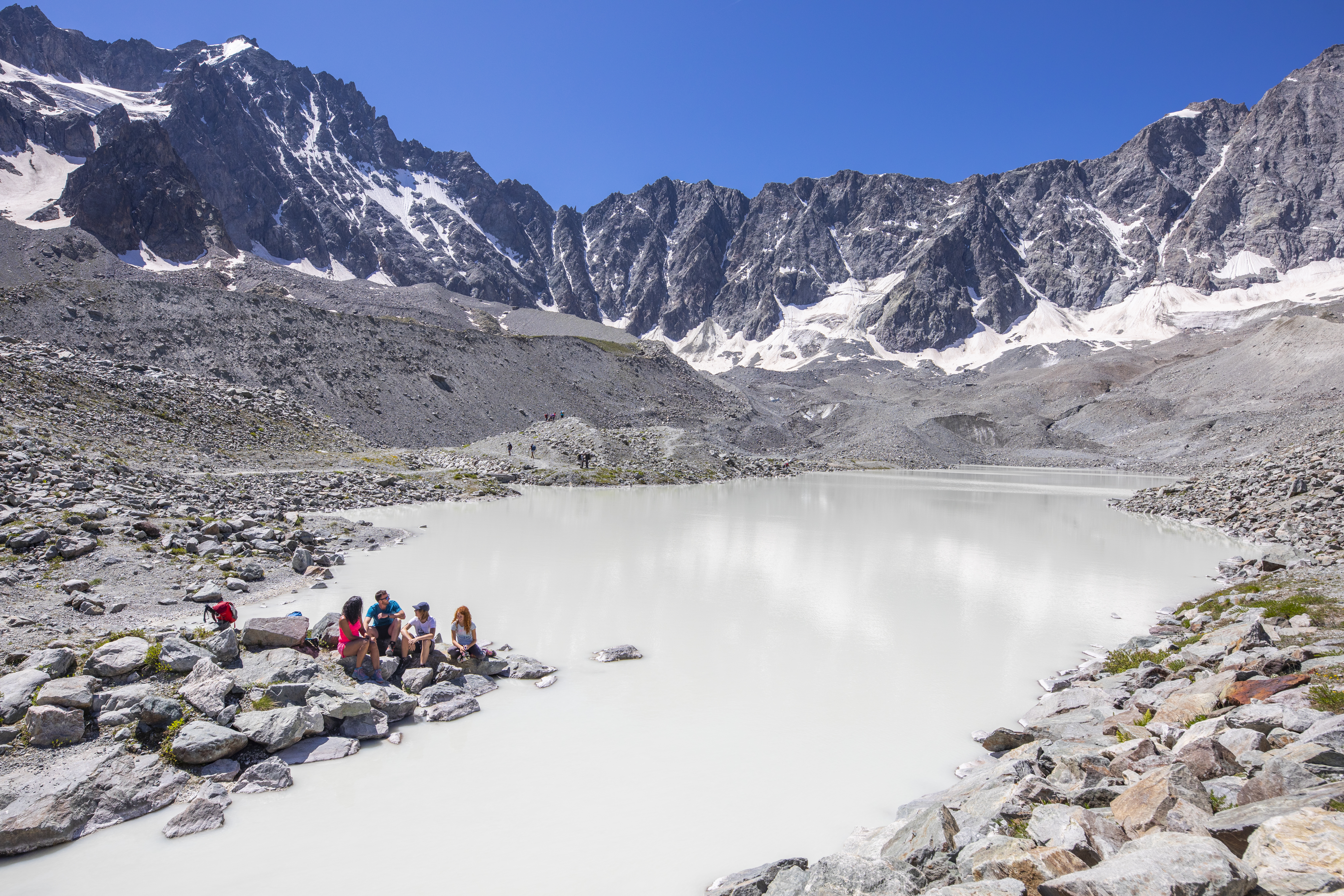
The Arsine Lakes
It is hard to imagine that just 60 years ago, the Arsine lakes did not exist and the entire site was covered by ice. Over time, plant life has colonised the new environment: purple saxifrage, creeping avens, campanula cenisia, genepi. There is even life in the cold water of the lakes.
Description
From the car park at the entrance of Casset, near the Park information centre, head up the hamlet by the main street and cross the second bridge over the Guisane, on the left. A straight track follows the Petit Tabuc stream and leads progressively from the hayfields into the woods. Beyond the barrier and the Clot du Gué bridge, a steady climb leads through the larch forest up to Grand Pré glade (1683 m), then on to the Douche lake (1901 m). The heart of the Ecrins National Park starts on the other side of the ford made of wood and stones. A winding footpath over a large area of scree gives well-deserved access to a mineral valley, populated with chamois. In the distance, on the right, the shepherd's mountain hut reminds us that the area is used for grazing. The footpath continues on the right of the valley and ends at the Arsine pass (2340 m). This is where you will leave the GR 54 to go over the frontal moraine of the Arsine glacier. From this ledge created by the movement of the glaciers, two large lakes mark the end of the route (2455 m). The Arsine glacial cirque is overlooked by majestic summits: you will marvel at Les Agneaux and the Neige Cordier Peak. Return by the same route.
- Departure : Le Casset (Le Mônetier-les-Bains)
- Towns crossed : Le Monêtier-les-Bains and Villar-d'Arêne
28 points of interest
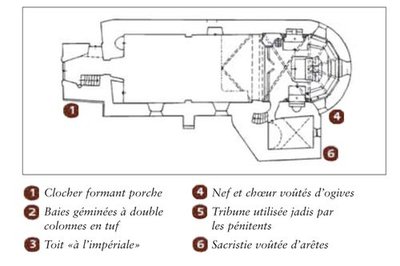
Plan de l'église du Casset - PNE  History
HistoryChurch of Saint-Claude
Formerly a chapel, its existence recorded in 1500, this Romanesque building became a parish church in 1826. It is dedicated to Saint Claudius of Besançon. "In former times, the people of Le Casset used to go on a pilgrimage to Saint-Claude in the Jura." On the saint's feast day (6 June), a mass is celebrated. "Two days beforehand, the women of the village clean and decorate the church." Then, the people take an aperitif in the café opposite the church. Visits to the church are organised by the Tourist Office all summer.
 Architecture
ArchitectureSaint Claude’s church in Le Casset
With its disproportionately high spire, the Casset church never goes unnoticed. Its four-sided Comtois steeple was modelled on the collegiate church in Briançon. The church is listed as a Historic Monument and is placed under the protection of Saint Claude. In its present condition, it dates from the 18th century. The previous building was constructed prior to the 16th century. Inside, the eye is immediately attracted by the choir ogives, creating an intimate atmosphere, particularly since the unusually large spire does not suggest an interior of such a small size. The choir was rebuilt in 1716-1717, probably after the previous chapel burnt down. Traces from this period can be seen on the keystone. The wrought-iron choir gate has the inscription "HM 1717", a date that can also be seen in the apse, on the wrought iron railing of the impost of the axial window, and on the baptismal font.

Cadran solaire au hameau du Casset - Claire Broquet - PNE  Architecture
ArchitectureSundials
As you walk through the village of Lauzet, you will see recently made sundials made in traditional style. Easy to see from the main village streets, they adorn the beautifully restored facades of the old houses.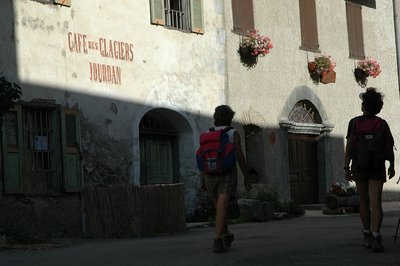
Dans le hameau du Casset - PNE - Masclaux Pierre  History
HistoryLe Casset
At the entrance to the valley, Le Casset is a stone shell village surrounded by farming landscapes. Its name comes from the verb 'cassare' ('to break, to shatter' in late Latin), describing a place covered with stones. In fact there are many such villages in this mountain valley carved out by a vast glacier. Le Casset, on the left bank of the Guisane, is sheltered from avalanches beneath the watchful eye of the prestigious summits and glaciers that “move” in a different time scale from our own.
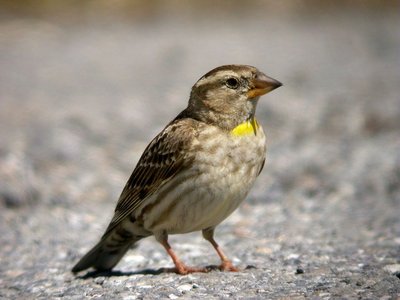
Le moineau soulcie - PNE - Combrisson Damien  Fauna
FaunaRock sparrow
The rock sparrow is here at the north-western limit and highest altitude of its home territory and regularly nests in the area. The species is in decline nationally and is on the endangered ‘red’ list in Rhône-Alpes and is being studied in the PACA region. People sometimes pay little attention to house sparrows since they are so familiar, which is a pity. The rock sparrow is bigger and although its plumage is similar to a female house sparrow’s, its call sets it apart at once: pi-yip or pi-yui or even a chay sound that is similar to a brambling’s!
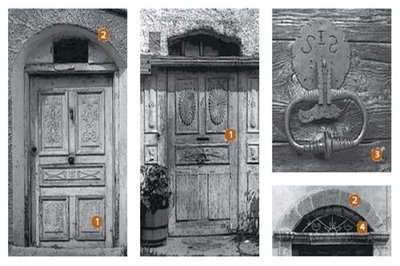
1.Ventaux de porte décorés, 2.Arcs en plein-cintre, 3.Marteau en bronze forgé, 4.Imposte en éventail - PNE  Architecture
ArchitectureDoors and courtyards
As you stroll through the streets of Le Casset, some house doors will attract your notice, as they bring together most of the decorative elements of the facades. Made of larch wood, they have been moulded or sculpted with geometric or floral patterns and have a tympanum above them, often with a grating. Behind the door is the courtyard, the shared entrance for people and animals. The way people lived and organised their homes resulted in this single entrance, an area giving access both to the stable and to the living quarters. Between the world inside and outside, the courtyard provided a passageway, insulation, but also storage space.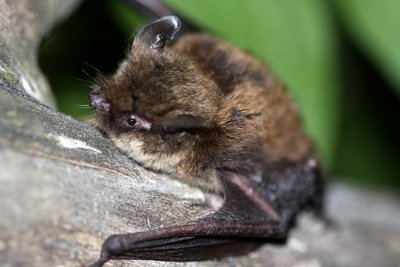
Le murin à moustaches - PNE - Corail Marc  Fauna
FaunaWhiskered bat
The whiskered bat is a dark-faced bat. It is quite common in certain mountain regions and is one of the most frequent species after it cousin the common pipistrelle. It likes trees, be they on the banks of a river or in the high altitude forests, but it is also possible to catch sight of them in gardens and villages such as the hamlet of Casset. This small mammal lives on flying insects and thus helps in controlling their numbers. Like all mammals, the female feeds her sole offspring with her milk.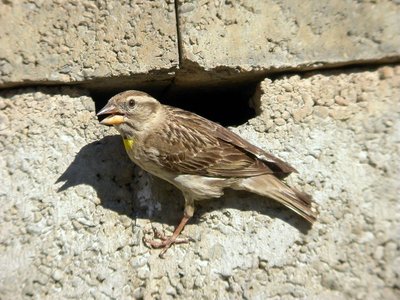
Le moineau soulcie - PNE - Combrisson Damien  Fauna
FaunaLover of old stones
The rock sparrow is a sedentary bird. It generally settles in well-exposed, agricultural areas where there are lots of stones, stone terraces, ruins, piles of stones, old buildings. This southern sparrow can be found up to an altitude of 2000 m provided there is an open landscape and many mineral elements. It nests in the hole of a rock, in a wall and sometimes under the roof of a house. It will then mingle with the house sparrow. A sociable bird, it lives in small, dispersed colonies.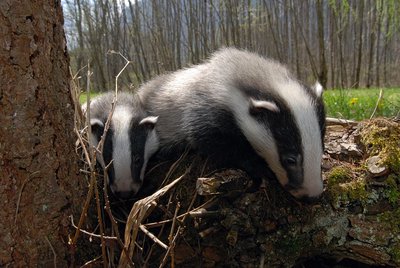
Deux jeunes blaireaux - PNE - Fiat Denis  Fauna
FaunaEuropean badger
You will often see a badger at nighttime on the edge of a path, a road or an embankment. The gentle pace and portly gait of this member of the mustelid family are reminiscent of a small bear you may get a glimpse of his black and the white stripes on his head before he hurries away. Worms, reptiles, frogs, fruit and plants are his staple diet. Families of badgers live in sometimes very extensive and very old burrows, with numerous chambers and galleries. They are tolerant animals, since they will sometimes share their home with rabbits and foxes. Badgers are among the unobtrusive neighbours whose presence goes undetected, except for their footprints made up of five nearly parallel toes and the tracks of their long claws.
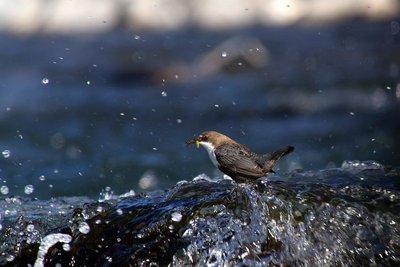
Cincle plongueur avec son repas dans le bec - Damien Combrisson - PNE  Fauna
FaunaWhite-throated dipper
The mountain streams relinquish their secrets to an attentive hiker. The master of this little world is a small brown, red and grey bird with a short tail and a pure white breast, separated from the darker abdomen by a light brown stripe. We can often see it in the air, flying close to the water to snap up insects. The dipper owes its name to its eating habits to find water larva, it dips its head into the water and grips the riverbed to walk against the current.
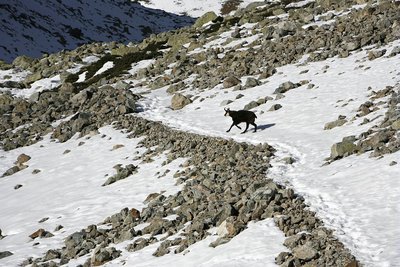
Chamois mâle au moment du rut dans le vallon du petit Tabuc, à proximité du Mônetier-les-bains - Cyril Coursier - PNE  Fauna
FaunaChamois
Rupicapra rupicapra, the mountain goat was not at first solely a creature of the mountains. The species is more attached to rocky escarpments and steep slopes than high altitude. But strong human pressure on chamois made them withdraw ever higher. Coveted as a hunting target, they have found refuge here in the Ecrins National Park.
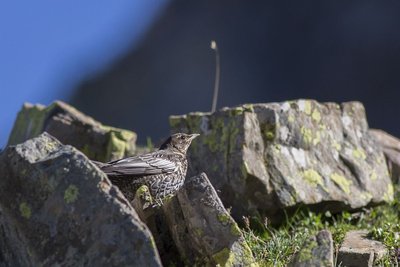
Jeune merle à plastron - PNE - Saulay Pascal  Fauna
FaunaRing ouzel
In the pastures covered with larch or 'bush", a cry of alarm followed the start of a song resounds. A blackbird? Yes, but more specifically a ring ouzel. This shy, swift mountain blackbird lives on the fringe of the larch, scots pine, spruce or Swiss pine forests between 1000 and 2500 m in altitude. The ring ouzel is a migratory bird that spends winter in Spain or North Africa before coming back to the mountains around March.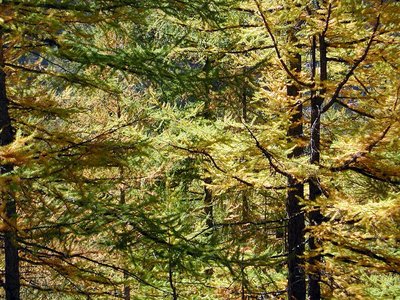
Mélezin - PNE - Quellier Hélène  Flora
FloraLarch
The larch is the only European resinous tree to lose its needles in winter. Its wood is red-brown. It stands out in the landscape with its leaves ranging from a soft green colour in spring to gold in autumn. Its pink flowers attract naturalists and photographers in the spring. The larch tree is a coloniser of mountain slopes. Although it is at home in the harsh conditions of the mountainside, it cannot bear competition from other trees. The Petit Tabuc site is a fine example of its colonising capacity, even though it is regularly hit by avalanches.
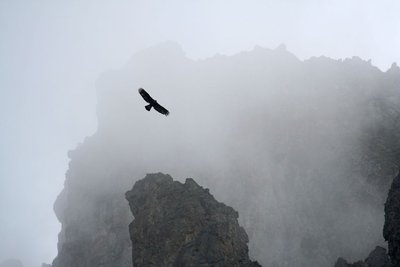
Aigle royal dans la brume - PNE - Telmon Jean-Philippe  Fauna
FaunaA flying predator
The eagle is the archetypal predator. Everything about it suggests strength and daring. Its appearance, of course, with its impressive expression highlighted by the prominent brow ridge, but above all its fearsome weapons: rapid flight, which can be adapted to even the most acrobatic situations, and sharp, powerful talons. Its keen eyesight helps it detect its prey, from the marmot to the young chamois, ptarmigans and hares. In winter, it often takes its food from the dead bodies of animals, helping towards the natural cleansing of nature.
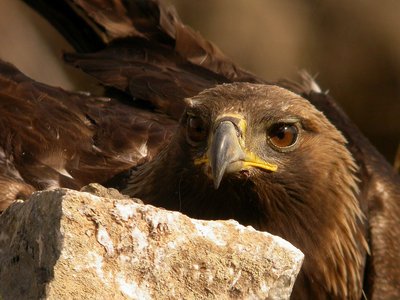
Aigle royal - PNE - Combrisson Damien  Fauna
FaunaGolden eagle, the Ecrins' mascot
The Petit Tabuc site is ideal for the golden eagle to nest. The golden eagle is amongst the protected species that are considered rare in Europe. The size of the populations that have been registered in the Ecrins massif, bestow a strong responsibility on the Park for conservation of the species. Counting takes place regularly since 1985 along with monitoring of reproduction, causes of disturbance and mortality.
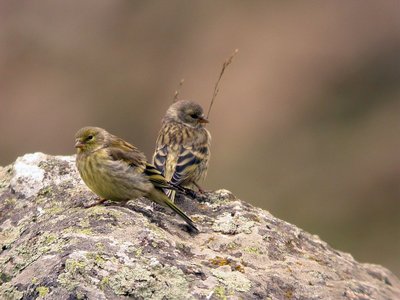
Deux venturons montagnards - PNE - Combrisson Damien  Fauna
FaunaAlpine citril finch
A small green-yellow-grey bird sways on a tall branch. Chet! The Alpine citril finch flies off to land on a scrap of threadbare grass. It looks like a small greenfinch, but the strident cry it makes during its short flight clearly sets it apart. Its head and breast flanks are a pretty blue-grey colour. Its yellow wing stripes can be easily seen. When flying over longer distances, its undulating flight is reminiscent of a goldfinch’s. And just like its cousin, the finch is sociable and moves about in small groups when exploring some sparse group of nettles or grass.
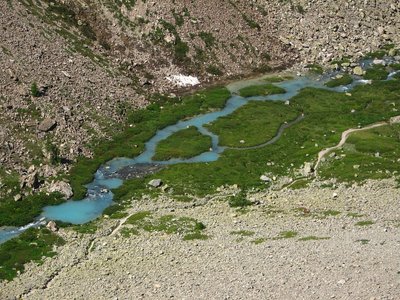
Eaux turquoises du Petit Tabuc - PNE - Coursier Cyril  Water
WaterWater colour in the meanders
The turquoise colour of the water that meanders from the Petit Tabuc stream gives a special character to this remarkable site. The valley is popular among photographers and artists for its photographic and pictorial quality.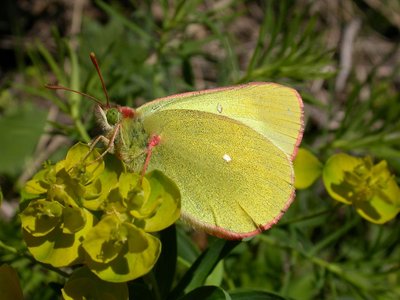
Solitaire mâle sur une euphorbe - PNE - Delenatte Blandine  Fauna
FaunaMoorland clouded yellow
The heath surrounded by heather and willows is the home of a population of unusual and protected butterflies: the moorland cloud yellow. Elsewhere, it lives in different environments, such as blueberry heaths and peatland, where the moorland clouded yellow is rare and hard to spot. It can be recognised by its yellow display delicately sprinkled with grey under the rear wings of the male, while the female of the species has adopted almost purely white wings. They both wear a simple pink border highlighting the edge of their wings, with a tiny white ocellus (eye) encircled with brown and a discrete grey crescent.
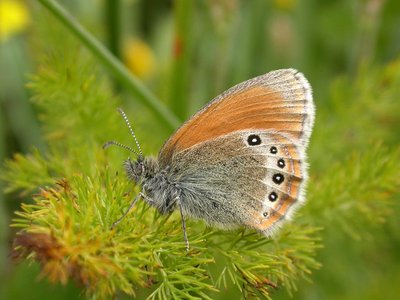
Satyrion (papillon de jour) - PNE - Delenatte Blandine  Fauna
FaunaButterflies and moths
Butterflies can be distinguished from moths by the shape of their antennae. You will also notice that when resting, the butterflies wings are vertically folded over the body for necessary discretion while the moth's cover them. The moorland clouded yellow butterfly has another unusual habit: as soon as it becomes too cold to fly, it settles and bends its side to the sun to absorb energy. It can even lean slightly, whereas others tend to fully, and dangerously spread themselves out.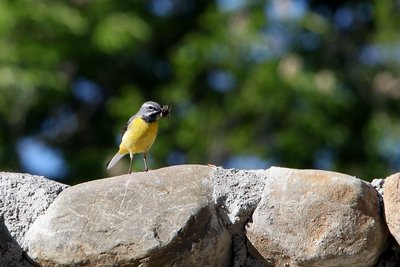
La bergeronnette des ruisseaux - PNE - Saulay Pascal  Fauna
FaunaGrey wagtail
The grey wagtail elegantly hops along the rocks at the riverside. They are found in mountain streams, but also near all waterways in the mountains, in the countryside or in towns, and even small high-altitude lakes. Like other wagtails, they continually wag their long black tails edged with white. They have yellow breasts like the western yellow wagtail, but their backs are ash grey. In the mating season, males proudly show off their black throats, making it easier to tell them apart from females, whose throats and breasts are partly white. Their pinkish claws are specific to the breed, since other wagtails’ claws are black.
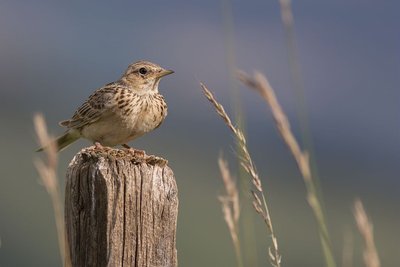
L’alouette des champs - PNE - Saulay Pascal  Fauna
FaunaSkylark
This bird is like a tightrope walker suspended in the sky, sounding out a long chorus of notes. Then, triangular wings back, and in a perfect spiral, the bird lands in the middle of the prairie. On the ground, it is difficult to see: its varying shades of brown means it is very well camouflaged. In its search for food, its movements, which are a succession of small sprints and sudden halts, enable it to spot possible predators.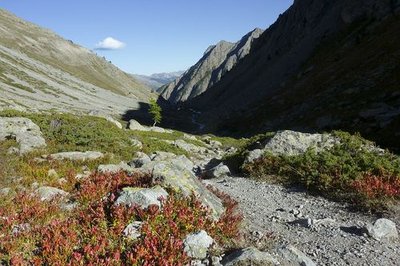
En descendant du col d'Arsine, sous les chalets du même nom. Vue plein est. - Cyril Coursier - PNE  Pass
PassArsine pass
The Arsine pass, is an important crossing point to visit on the GR54 Tour des Ecrins et de l'Oisans. It gives a remarkable viewpoint over the Angeaux massif. The pass is part of an old itinerary that was used instead of the crossing point by the Lautaret pass. It is also a crossing point between the Guisane and the Romanche area. This is an area that was mentioned as early as the Middle Ages as a place of conflict between the districts of Villar d'Arène and Monétier-les-Bains.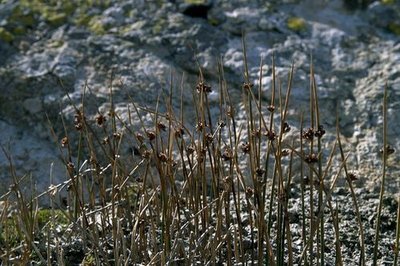
Jonc arctique - Bernard Nicollet - PNE  Flora
FloraArctic rush
Even though it is relatively common in some acidic marshland, the Arctic rush is nonetheless protected throughout the Rhône-Alpes and Provence-Alpes-Côte-d’Azur regions. It can be recognised because of its total absence of leaves and by the few blackish flowers in the upper third of the stalk. The flower tepals open at an obtuse angle and are a little shorter than the capsule.
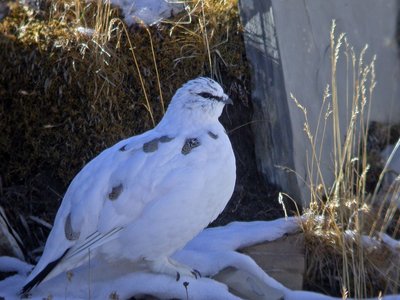
Le lagopède alpin en plumage d'hiver - PNE - Combrisson Damien  Fauna
FaunaRock ptarmigan
At five in the morning in the month of May, at an altitude of over 2,000 m, the sun rises over the fields of blueberry, which appear above the patches of snow. All of a sudden, a hoarse, almost metallic cry cuts through the peaceful dawn atmosphere: the rock ptarmigan is in the midst of its nuptial parade. Originating from the Arctic tundra, the rock ptarmigan, sometimes called the snow partridge, was to be found all over Europe during the ice ages, before its living space was limited to the mountains. Even today, it finds the conditions it needs to survive. The national Alpine parks have a great responsibility in conserving this species. The inventory carried out by the Haute-Romanche nature unit in 2005 showed there was a large core group of birds on the site.
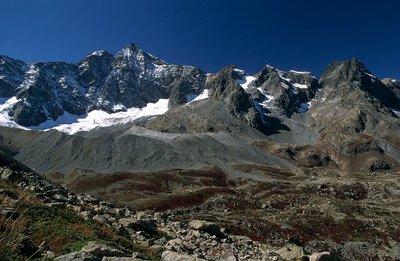
Anciennes moraines colonisées - PNE - Nicollet Bernard  Glacier
GlacierMoraines
The site of Arsine offers a complex moraine environment with a parade of ice margin flowers. The frontal moraine of the Arsine glacier is on a glacial vegetated rock complex that occupies about forty hectares at the bottom of the cirque. This complex is likely to have come about through a shifting of abandoned glacial deposits after permafrost was established. This means that the ground maintains a temperature of 0°C or less over several years. This phenomenon is likely to have taken place during the recent Dryas climatic cooling, that is to say 11 000 – 10 000 years BC.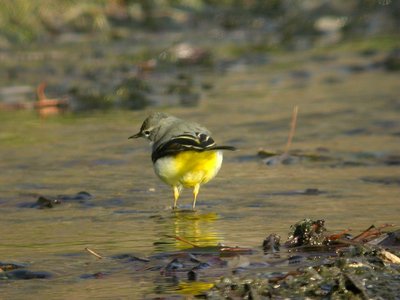
Bergeronnette des ruisseaux - PNE - Combrisson Damien  Fauna
FaunaAquatic diet
The grey wagtail is "hyperactive" and has a diet of flies, mosquitoes, dragonflies and all sorts of aquatic insect larvae. It hunts at the edge of the water, by jumping from stone to stone or hovers to catch its prey. It sometimes fishes for shellfish, molluscs, or even small fish to complete it meals. It does not leave the damp banks to build its nest either, and even looks for somewhere close to a waterfall or to flowing river.
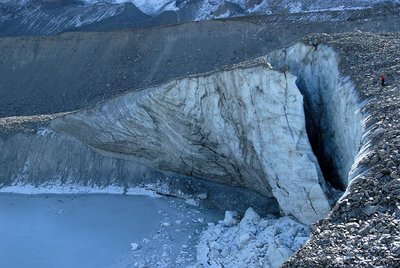
Détachement imminent d'un bloc du glacier - PNE - Masclaux Pierre  Glacier
GlacierIce calving
When the lake is frozen and the air temperature rises, the ice expands, provoking what is called the “song of the lake". The Lac Ouest is the last lake in the mountain range where it is still possible to see the fall of seracs (the front of the glacier) into the water, giving rise to this muffled noise.

 Glacier
GlacierThe melting Arsine glacier
Lake Arsine came to life in the 1950s after the Arsine glacier melted. Due to its rapid development, it was measured more accurately in 1969 and 1985, showing 800,000 m3 of water contained in a moraine that had been weakened by the ice inside it. Since it threatened to break, emergency work was undertaken the following spring to stop the rise in the level of the lake using a regulation channel dug across the frontal moraine. Almost 30 years later, the glacier site is still carefully monitored by Park employees. And the risk is now completely ruled out.
Forecast
Altimetric profile
Sensitive areas
Golden eagle
- Impacted practices:
- Aerial, , Vertical
- Sensitivity periods:
- JanFebMarAprMayJunJulAug
- Contact:
- Parc National des Écrins
Julien Charron
julien.charron@ecrins-parcnational.fr
Recommandations
 In mountain pastures, protection dogs are there to protect the herds from predators (wolves, etc.).
In mountain pastures, protection dogs are there to protect the herds from predators (wolves, etc.).
When I hike I adapt my behavior by going around the herd and pausing for the dog to identify me.
Find out more about the actions to adopt with the article "Protection dogs: a context and actions to adopt".
Tell us about your meeting by answering this survey.
Information desks
Information center "le Casset" (summer only)
Le Casset, 05220 Le Monêtier-les-bains
At the entrance of the hamlet of "le Casset" and near the core zone of the Park, a stop before or after your walk... Projections, documentation, books of the Park. Free admission. All animations of the Park are free unless otherwise stated.
Access and parking
Le Casset 17 km from Briançon by the D1091 and D300.
Parking :
Source

Report a problem or an error
If you have found an error on this page or if you have noticed any problems during your hike, please report them to us here:


